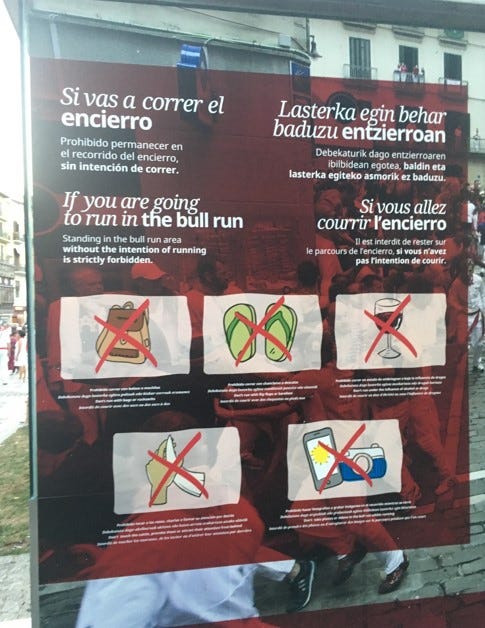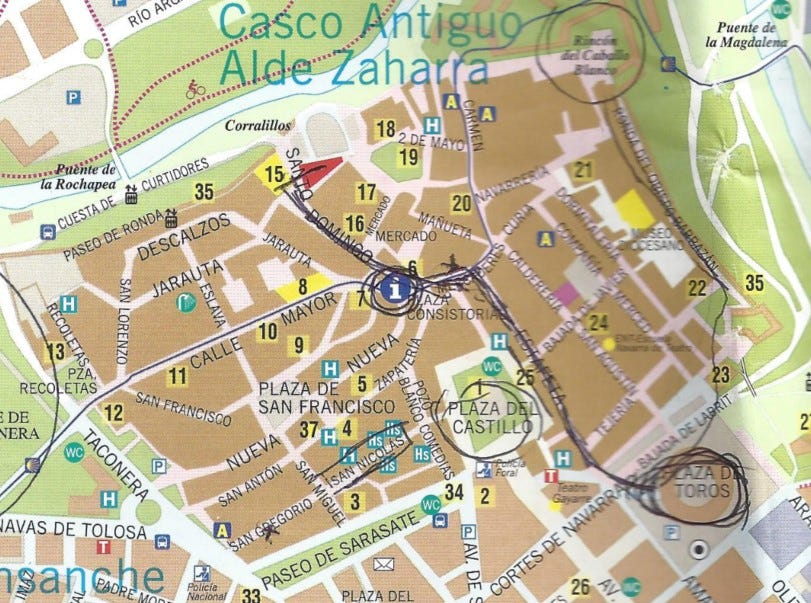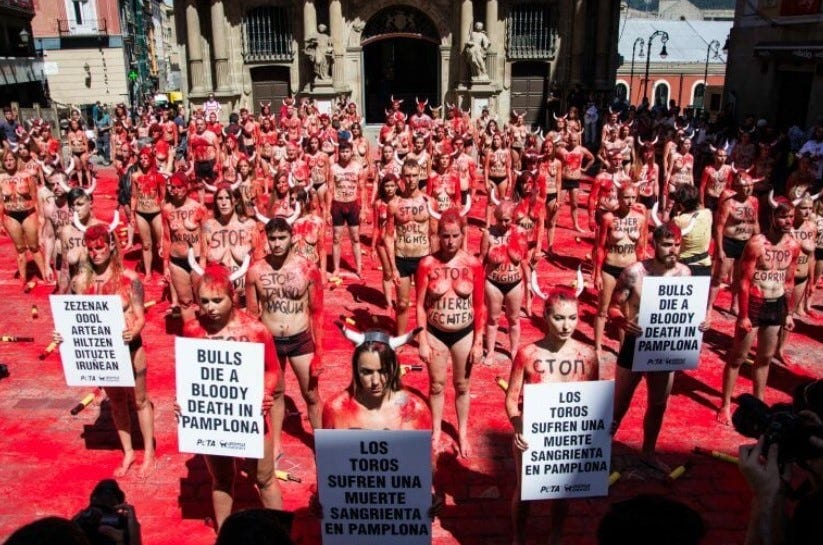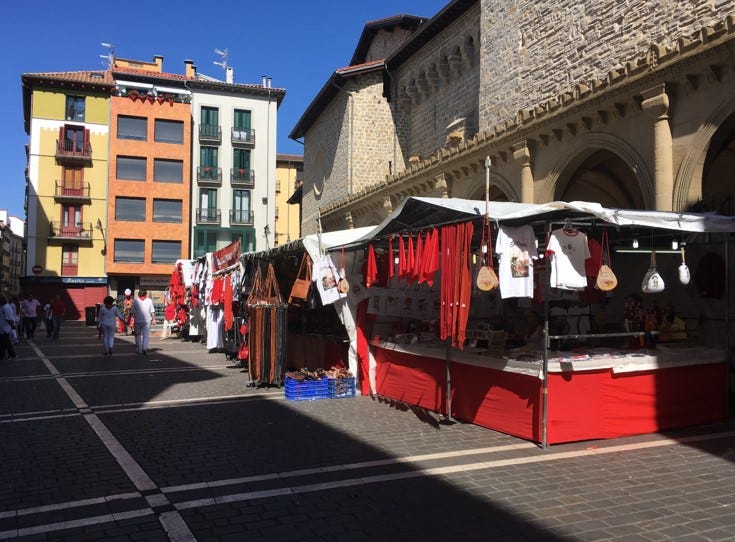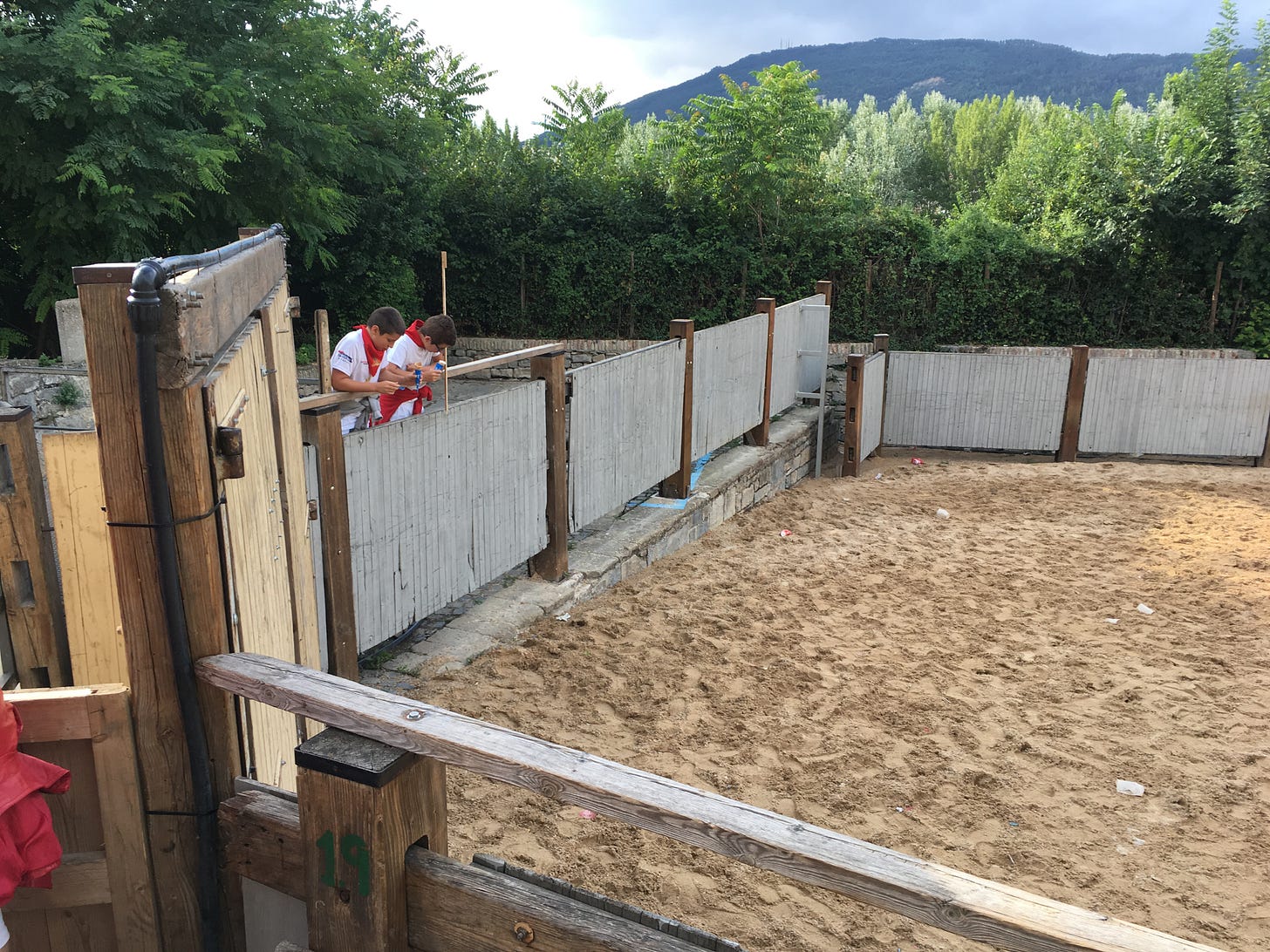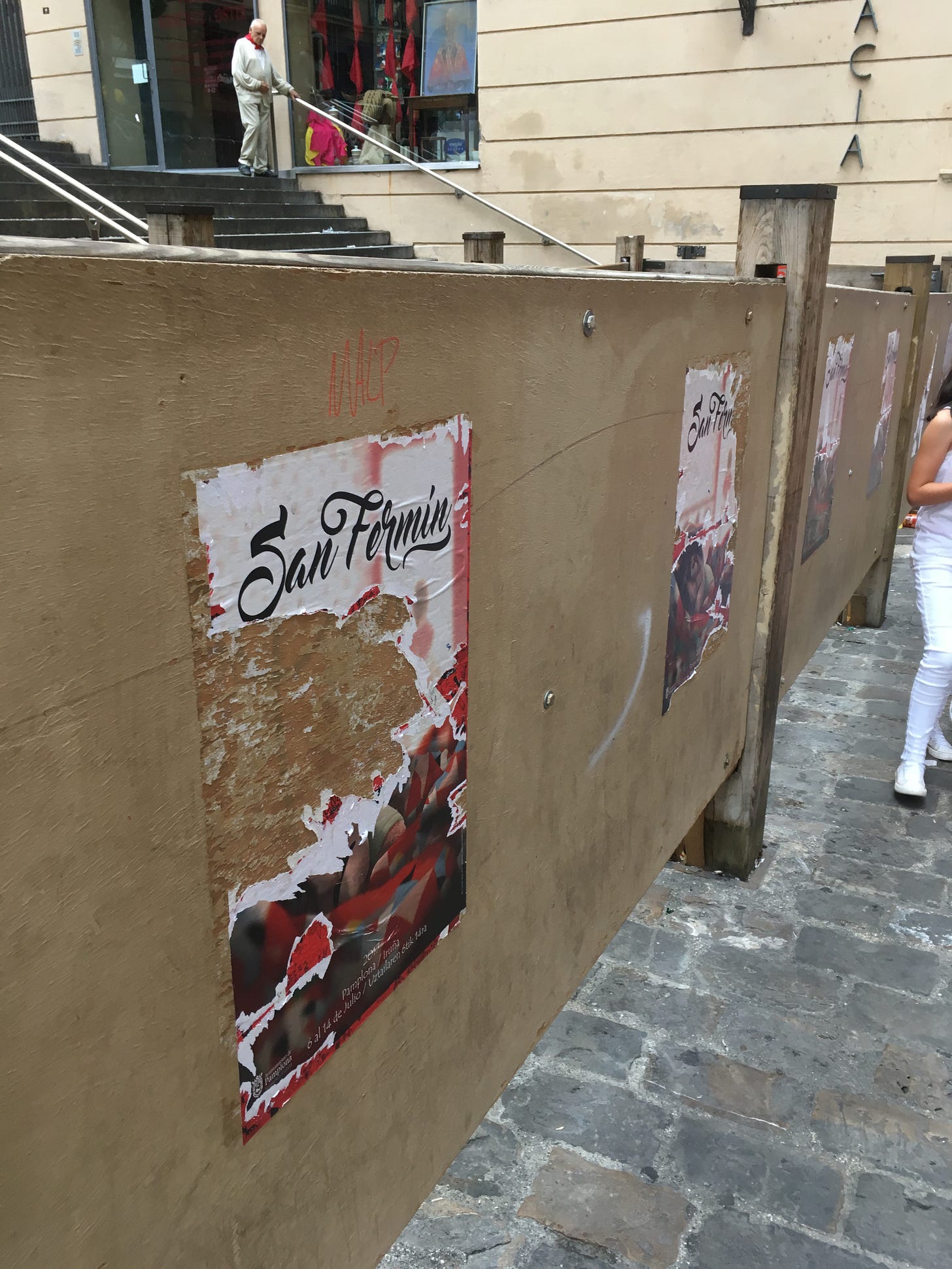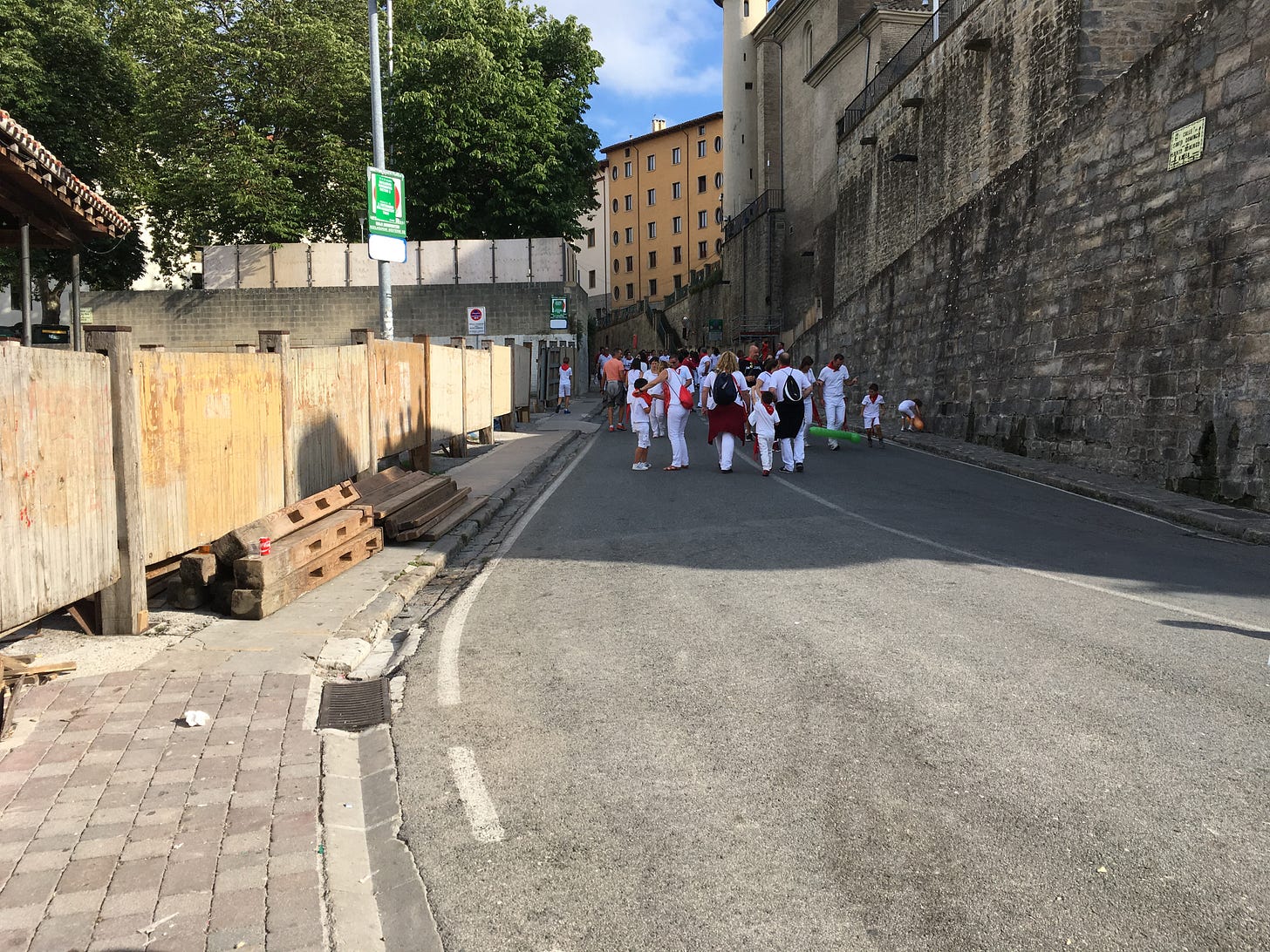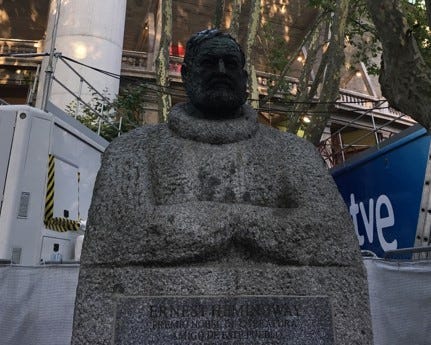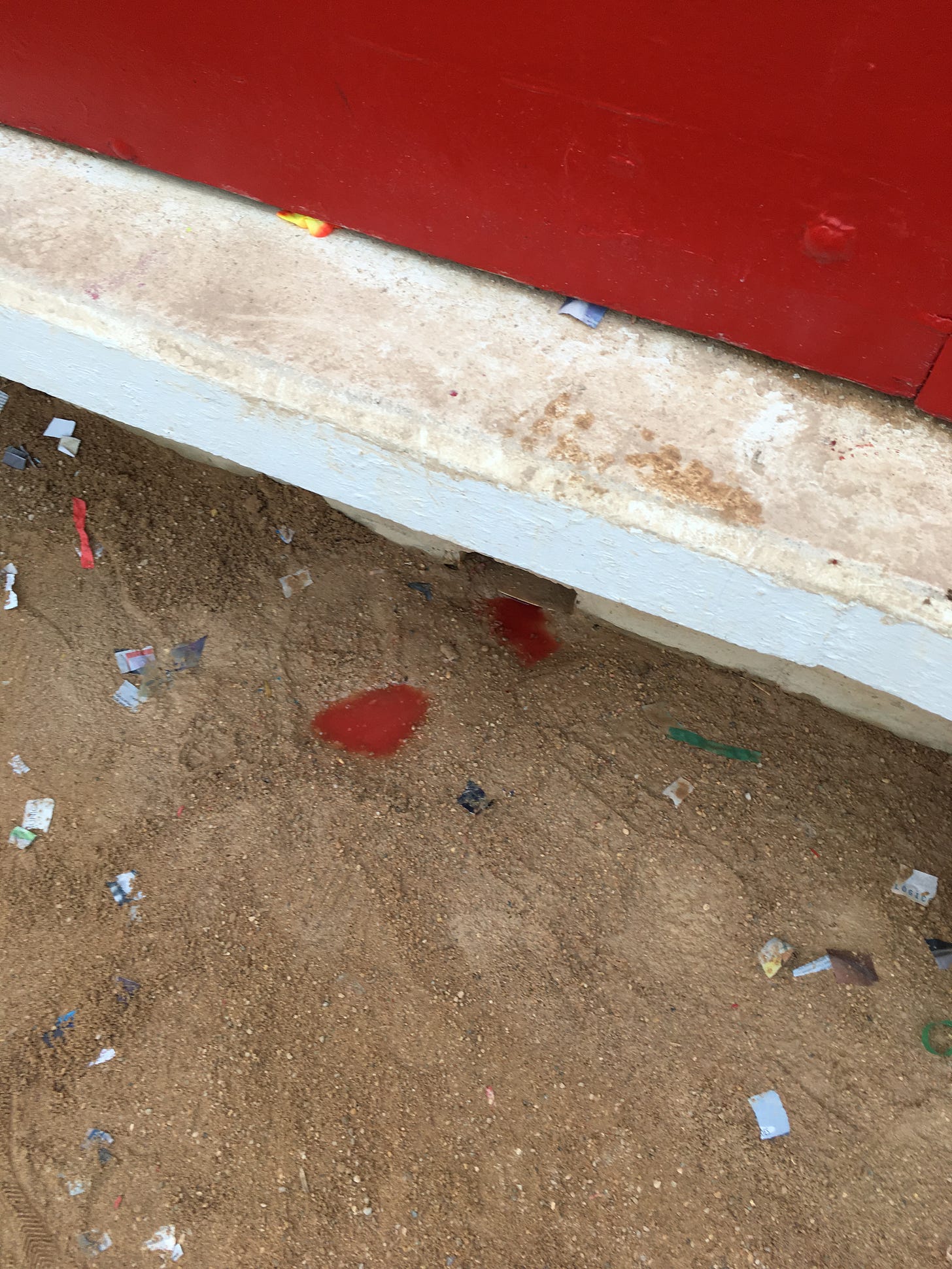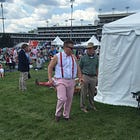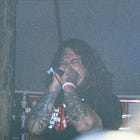Toros & Tubas: Bienvenidos a Pamplona
Disclaimer: This story has pictures and descriptions that some people may not like.
The Spanish word for “killer” is matador.
•••
We had been married for a year when Paige and I decided to take one last big trip before kids. We didn't know at the time that getting pregnant was more complicated than just having unsafe sex, which meant the following year we took our “second annual last big trip before kids,” and then when we went to Hawaii the year after that we stopped the joke since it wasn't funny anymore. But in 2017, we were full of hormones and ambition— deciding to cram five European countries into a two-week window since we were convinced that without birth control, we would never get the opportunity to do anything ever again. Iceland had been getting a lot of buzz lately. Icelandic Air had some stopover policy where you could stay up to two weeks on a layover in Iceland without paying extra. I'm not sure if it was really a deal or not, but Iceland sounded cool. While we were in Iceland, we might as well go to England, and while we were in England we might as well go to Ireland, and while we were in Ireland we might as well go to France. Once you start listing off European bucket list items, the itinerary gets full quickly— but the entire schedule centered around one date that was inflexible. We needed to be in Pamplona, Spain in the second week of July to witness the Running of the Bulls.
•••
By the time we arrived in Pamplona, we had been to: Chicago, Dublin, Cork, London, Oxford, Stonehenge, Paris, and Barcelona. Each night we fell asleep with the knowledge we had seen one of the most amazing destinations on earth earlier that day, and each morning we woke up knowing we would be seeing another one later that afternoon. Even after we were through with Pamplona, we still had Madrid and Reykjavik to look forward to. But we weren't looking that far forward. There was too much immediately in front of us.
All our destinations up to this point had been static. We had seen amazing things, but those sites were frozen in place. During the Festival of San Fermin, Pamplona is a powder keg that has been lit in series next to six more powder kegs. And each morning of the festival a new one blows.
“At noon of Sunday, the 6th of July, the fiesta exploded. There is no other way to describe it. People had been coming in all day from the country, but they were assimilated in the town and you did not notice them. The square was as quiet in the hot sun as on any other day. The peasants were in the outlying wineshops. There they were drinking, getting ready for the fiesta. They had come in so recently from the plains and the hills that it was necessary that they make their shifting in values gradually. They could not start in paying cafe prices. They got their money's worth in the wineshops. Money still had a definitive value in hours work and bushels of grain sold. Late in the fiesta it would not matter what they paid, nor where they bought.”1
- Ernest Hemingway
We were staying in an Air Bnb— an apartment that promised to be in the heart of the festival. Our Air Bnb host met us at the end of the street where cars were still permitted. A taxi could never make it to the apartment’s doorway through the throngs of college students, tourists, Spaniards, farmers, families, and other humanity—all dressed in white shirt and red scarf, most fully intoxicated or taking a break from the previous day of drinking in preparation for a subsequent day of drinking. Signaled by frantic waving and aided by Google Translate, Miguel guided. He knew these streets— he had traveled them many times before. We felt safe with him, convinced that wherever he led us, it would be ok. These roads were foreign to us, unfamiliar, scary—and the mass of humanity in front of us set us on edge. We followed Miguel down the worn cobblestone streets, dodging one clueless partier and running straight into others in spectacular collision. We would lose sight of Miguel and grow anxious, but when the crowd parted and he was in our line of sight, everything went back to calm. The chaos was unceasing until Miguel led us through a wooden door to our lodging, corralling us safely until we were led back into the frenzy later that evening.
It was Day 3 of the Festival of San Fermin, and we were told it had been “quieter.” Pamplona grades levels of tranquility on a sliding scale. The festival takes place over 9 days, starting on July 6th. On the morning of July 7th, six bulls and six steers are released from their stables on one end of old Pamplona until the herd reaches the bullfighting ring a half mile— 826 meters— away. And then they do the same thing each of the next seven mornings. And each morning, drunken and hungover idiots get in their path.
After that they have the rest of the day to party.
By the time we arrived, it had been hours since that morning’s encierro, which meant it had been hours since the street mobs had started to party. There had already been five gorings of runners in the three races, including one in the scrotum. A goring is counted any time the horn of an animal pierces human flesh, which means that if you just get knocked down, trampled by a 1,500-pound animal, tossed by another, and then left in the street while other runners step over the top of your unconscious body— well, that doesn't count on the score sheet. Most of the festival goers know the running total of gorings and are eager to update it each morning.
Another tradition occurred the day before when PETA held their annual topless protest in the public square. This year’s protesters wore horns and wrote “STOP BULL FIGHTS” across their bare chests. Bodies were covered in fake blood and female nipples were covered with pasties (nice of them to keep it family friendly).2
We had no plans of getting intoxicated or naked and covered with fake blood, but we did want to fit in. We located one of many make-shift souvenir tents and bought two white undershirts and matching red bandanas. My Spanish was rusty, but Pamplona is far enough from a major city that the English of the locals wasn't any better than my Español. I used the word for “grandma” instead of “wife” when telling the shopkeeper that I was also purchasing a scarf for Paige, but my gesturing and aggressive finger pointing helped clear up the confusion. Paige and I now looked the part, it was time to get our bearings.
And maybe something to drink.
In Spain, animals have intent.
The six bulls participating in the encierro that still have their testicles were bred and raised their entire lives to serve a single purpose: die at a bullfight. The bull runs begin at 8:00am and last approximately 2 - 3 minutes. At 6:30pm, those six bulls would be tricked, taunted, tortured, and killed inside the Plaza de Toros. And then six more the next day, and six more the next day, and six more the next day, and six more the next day, and six more the next day, and six more the next day, and then six more on the final day. Between 8:03am and 6:29pm though, the time is yours. It was a little after lunch and I was starving. We had no destination in mind as we wandered onto the streets, and neither did anyone else. At least not for a few more hours.
My favorite food in all of Europe was discovered a few days prior at a tapas restaurant in Barcelona. Anywhere that serves food in Spain has their ceilings covered with dangling pig legs—suspended by a cord tied to the pig ankle just below the hoof. The single leg is severed from the rest of the pig down the ass crack, and the rows and rows of hind quarters are lined along rafters in preparation for the next one to be hoisted down, screwed into a vice specifically designed to hold pig asses, and sliced into thinly shaved trimmings of perfectly cured pork only available in Spain. It’s called “jamon iberico” and it’s kind of like prosciutto, only it’s not really like prosciutto. It's fucking amazing. Paige told me that the pigs are only fed acorns and raised their entire lives to serve a single purpose: to be killed, have their asses split in half, dry cured, hung from a ceiling, and eaten. And today, one of them was going to be eaten by me.
Jamon iberico is not hard to find, you just walk down the street and look for the pig asses dangling in the doorways. Specifically designed plastic cups with a skewer are shoved into the bottom to act as drip trays, catching any remaining oils that slowly bleed out of the preserved carcass. We got jamon iberico sandwiches, which consist of jamon iberico and olive oil on a hoagie roll, and a side dish of padron peppers. Padron peppers are small and kind of like shishito peppers, only they're not really like shishito peppers.
As many, many, many had already discovered— the whole meal goes great with lots and lots and lots of sangria.
•••
We made our way to the bull route. Different ranches provide bulls for each day of the festival, and the night before the rancher brings the animals into a pen on the outskirts of Pamplona. We glanced into the corrals, but there wasn’t much to see yet. Paige recorded several videos for her Spanish class’s weekly “Mundo Miercoles” culture lesson, and then we hopped down to Calle Santo Domingo to follow the world's most famous cattle trail.
The streets in the old section of Pamplona are cobblestone and don’t follow a discernible grid. Wooden barricades line the sides of the route and are pushed to the side after the race has ended. As I inspected the frayed planks, it became clear how little separated San Fermin from disaster. But that was understood. That was part of the deal. Down Calle Santo Domingo, the path curves to the left between City Hall and Plaza Consistorial— the location of most of the parties and seminude protesting. The bulls are guided by six steers that run the route year over year and are familiar with the path. Bulls scare easily, and nothing freaks them out more than being isolated and encountering new things. The steers are meant to be a calming influence, docile guides that unwittingly convince their new friends to trample tourists before getting murdered. In Pamplona, there is a lot for a bull to be afraid of.
The herd picks up steam at Calle Mercaderes, which was also the location of our balcony for the next morning. The balconies are on upper-level apartments, and tour companies partner with residents to lease out viewing spaces throughout the festival. We found where we needed to report at 7:00am the next morning and carefully reviewed the instructions sent to us for tomorrow. Paige did an incredible amount of research for the entire European vacation, but her preparation for our time in Pamplona was a doctoral dissertation. The bull path was so windy, and the views so limited, and the options so expensive, that the choice of where to watch the running could make or break the entire outing. I jokingly (half-jokingly) told Paige I wanted to start out in the street and then hop out as soon as I saw a bull— but she wisely forbade me. Instead, she read blog after blog to find the best elevated view out of the path of potential gorings.
Calle Mercederes is known as “La Curva” for its, well, curva— but it meets a hard turn at Calle Estefeta, known as “Dead Man's Corner,” for its, well, dead men at that corner. It is there that 12 animals, each weighing between 1,500 and 2,000 pounds, must pull up from a dead sprint and make a 90-degree turn. Newton's first law states that an object in motion will remain in motion unless acted upon by an equal and opposite reaction, and his second law states that force equals mass multiplied by acceleration. If you do the math, that means that a bunch of bulls are going to have a really fucking hard time making that turn. Which means these minotaurs slam against the wooden barricades, get trapped, freak out, and ruin anyone's day stupid enough to get stuck in that corner with him. Paige made sure she got us balcony seats in perfect view of the corner.
•••
“I add that I firmly believe in the throwing of cushions of all weights, pieces of bread, oranges, vegetables, small dead animals of all sorts, including fish, and, if necessary, bottles provided they are not thrown at the bullfighter's heads, and the occasional setting fire to a bull ring if a properly decorous protest has had no effect.”3
-Ernest Hemingway
We followed the cobblestones down Calle Estefeta, the final stretch before the bulls enter the stadium and are corralled until the bullfights later that evening. As we hiked down this final run, there was a new noise— just barely noticeable at first—and then unavoidable. To this point, all we had heard was uncoordinated chaos, but coordinated chaos was picking up steam behind us. We were pummeled by the unmistakable noise of poorly played tubas. It was nearly 6:00pm, and the partygoers were more organized than I had realized. As the masses approached from behind, fiberglass tuba bells peaked above the white shirts, red scarfs, bedsheet banners, and poorly tuned drums. They were playing instruments that had clearly been in the family for decades for this sole purpose— and were singing, screaming, chanting, and drinking.
We let them overtake us, stepping to the side of the wooden barricades while the stampede proceeded past our small bodies and into the bull ring. The scene was odd and amusing. Bullfighting seemed to be something noble, involving pageantry and tradition, but these drunken adolescents descended into the stadium with less uniformity and reverence than a fraternity during a college football homecoming game. But they sure were excited about it. We were later told that Pamplona carries a stigma with it amongst bullfighting. It's the Waste Management Phoenix Open of bullfighting tournaments. Some matadors feed off the frenzy of the debauchery, but most of the serious ones feel it’s disgraceful to the artform and refuse to participate. But with bullfighting having been outlawed in Mexico, the venues for this pastime have dwindled and the festival of San Fermin has a lot of bulls to slaughter. Someone has to do it.
Tickets to bullfights are sold out years in advance with families purchasing season passes to all the fights throughout the festival. At no point did the topic of attending a bull fight come up in our trip planning. Until now. We found a kiosk outside the stadium to see how much a seat cost, learning of their sellout streak in the process. We noticed another ticket available for purchase, and after some translating, learned you could sit in the stands to watch the conclusion of the morning's encierro from stadium bleachers. We had only purchased the balcony view for one morning, and we were scheduled to be in Pamplona for two more days, so we bought passes with little idea what it was. Like the rest of the trip to Pamplona, I just let the day's plans unfold ahead of us and tried to stay out of the way.
There were plenty of ways to kill time, all that was needed was a place to people watch and a bottle of sangria—both of which we had plenty. We didn't venture far from the bull ring. There was a bust of Ernest Hemingway and a stand that sold keychains we later converted into a Christmas ornament. Cheers and tuba music could be heard from the grandstands inside as we watched breakdancing outside in blocked off streets. As time passed, crowds started to form outside the gates of the arena with an undisclosed purpose. They were waiting for something as patiently as a group of twenty-somethings could, who had run out of beer in the ice buckets they had been carrying around everywhere they went. There was one last cheer from inside, this one louder than all the rest, and the attendants swung open the gates to the stadium and a mob rushed inside. Paige and I made eye contact. We both raised our eyebrows and shrugged our shoulders— and without a word we cautiously followed the masses trespassing inside the bullfighting arena.
We tentatively walked around the overturned beer buckets and avoided the puddles of melting ice. The concourse wasn't vast, but it felt iconic. It had that authentic feel that old baseball parks do. The kind of aura that the walls had seen things that predated corporate sponsorships and tax increment financing. If the stadium had been in the United States, some planning board or ownership group would have pressured the City Council for renovations decades ago.
But this was Pamplona. Things were done differently here. We followed the roar and passed through an entryway to the grandstands unabated by any ushers or security. Inside was pandemonium. Screams, cheers, and tubas made it pointless to attempt speaking— not that Paige or I had any words for the scene we were taking in. A dead bull laid at the center of the ring and was in the process of being dragged out by a team of mules, harnessed to the toro carcass like reindeer pulling a Christmas sleigh. The exterior gates had opened when the final bull of the night was slain. It was as close as Pamplona comes to an attempt at crowd control— opening the vessel as wide as possible to allow the patrons to exit, making no attempt at obstructing the stampede of patrons without the funds or the hookups for bullfight tickets trying to get inside. We stood in the aisle as the crowd grew restless.
Each of the three evening’s matadors slowly walked to the center of the ring, saluted the crowd, and followed the path left in the sand by the dragging of bull carcasses. A beer bottle shattered on the floor inches from where I was standing. The blast of glass shards and the piercing noise indicated that it must have been tossed from the stadium deck above. I grew nervous. The mob of bullfight enthusiasts— fueled by booze and the hot Spanish sun— started hopping over the backs of bleachers, past families collecting their things, and stormed the center of the bullring. The fiberglass tubas were lowered across the wooden barriers meant to prevent a one-ton animal from goring the crowd. The motley crew of makeshift pep bands started the after party where six animals had been slain over the last two hours. No efforts were made to stop the pulse of drunkards, but with their absence in the stands my anxiety was sated.
“Should I go?”
“Yes. But I'm not. Take pictures.”
I joined the mob.
The side of the bullring had wooden panels periodically placed to allow for people to hide behind as the bull chased them. I closely inspected one of these barricades, freshly splintered wood could be seen from where the bull's horn pierced the plank and dug a cavity through the paint. There were standing pools of blood throughout the ring, puddling up from earlier and yet to be ground into the terrain by the hordes of tuba players. I walked to the center and took a panoramic photo of the scene around me. All 360 degrees of raucous festival goers, descending on the bullring like a student section storming the court after beating the Kansas Jayhawks.
I climbed back over the sides of the bullring, found my wife, and then found a slice of pizza, jamon iberico sandwich, and a 2-liter bottle of sangria for 8,80 euros.
To Be Continued.
The Sun Also Rises by Ernest Hemingway, pg. 140
https://www.peta.org.uk/action/pictures-protesting-the-running-of-the-bulls/
Death in the Afternoon by Ernest Hemingway, pg. 163





